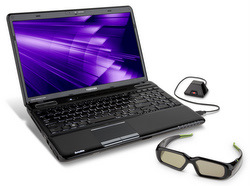New laptops take different approaches to 3D

My colleagues at ZDNet have been covering some of the 3D laptop announcements coming out of Toshiba and Lenovo. A boutique PC company, Origin, also unveiled a 3D laptop at E3 last week. These new notebooks join 3D models from Acer and Asus, which began shipping late last year. I recently spotted a few others on the show floor at Computex, and Nvidia and Microsoft have said they are also working with Alienware and Dell among others on so-called 3D PCs, so I expect to see more models in the near future.
So far all of these are mainstream laptops with 15.6-inch or larger displays. Don't expect to find an ultraportable laptop with this technology any time soon, largely because it requires a powerful processor and discrete graphics, but also because video looks best on a big, high-resolution display.
The category will become a lot more interesting as the hardware and movies for Blu-ray 3D become more widely available later this year, though not all 3D systems will support it (more on that below). In the meantime, why would you want a 3D laptop?
The most obvious use is 3D gaming. Existing games are relatively easy to convert to stereoscopic 3D, and there are already hundreds of popular games that work to varying degrees with 3D display technology. I've tested several of them using Nvidia's 3D Vision, and the quality is surprisingly good. The options for 3D video-both broadcast and online-are slowly expanding as well. YouTube has some content in 3D, and at Computex earlier this month, Nvidia and Microsoft demonstrated a 3D version of Silverlight for streaming video. Finally you can use a 3D laptop for digital photography. Fujifilm already sells a 3D point-and-shoot, the FinePix Real 3D W1, which captures both stills and video. Sony is also working on 3D cameras (and plans to add a 3D Sweep Panorama mode to its new Alpha NEX-5, though this will only work on compatible Bravia 3D LCD TVs). You can also convert existing video and photos to 3D using a third-party software package, but based on the demos I've seen, the results aren't as good.

The IdeaPad Y560d will start at about $1,200 with Core i3/i5 dual-core processor and ATI Radeon HD5730 graphics with 1GB of memory. A Blu-ray drive will be available on some models, but it can't be upgraded to support Blu-ray 3D. The IdeaPad Y560d also includes TriDef Media Player, which converts standard video to 3D, and TriDef Photo Transformer, which converts photos to 3D. The Acer Aspire 5738DG was the first laptop to offer this TriDef 3D technology. The specs haven't been updated but the 15.6-inch laptop is still available online for around $750 with a Core2 Duo processor, 4GB of memory, ATI Radeon HD 4570 integrated graphics, 320GB hard drive and DVD burner.
Toshiba is taking orders for the Satellite A665 3D Edition, but the Lenovo IdeaPad Y560d won't ship until teh end of June. I have yet to see full reviews of either laptop, however, CNET has reviewed the ASUS G51J 3D and Acer Aspire 5738DG, and these reviews do a nice job of evaluating the two different approaches to 3D. Of course the technology (and content) is improving all the time, so I look forward to getting a closer look at these new systems.